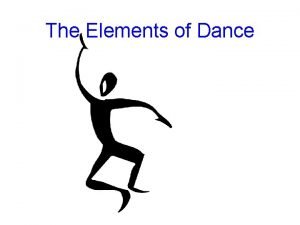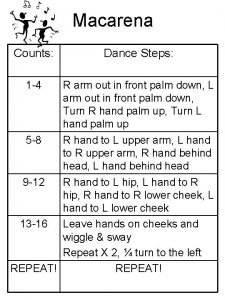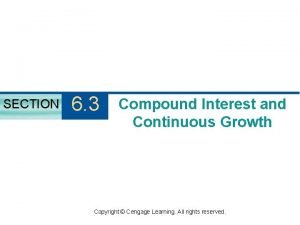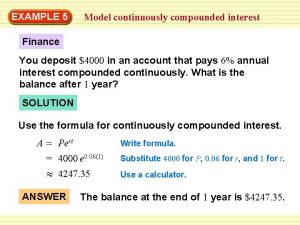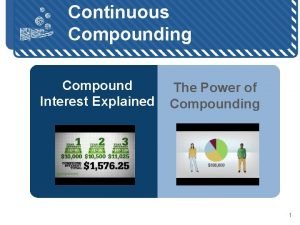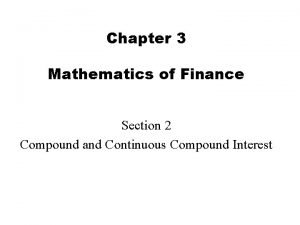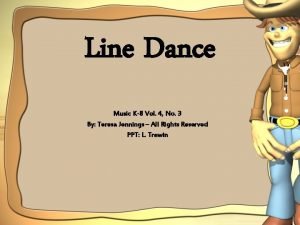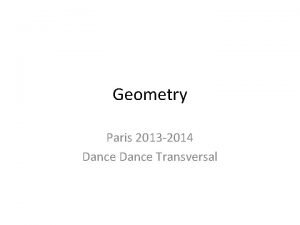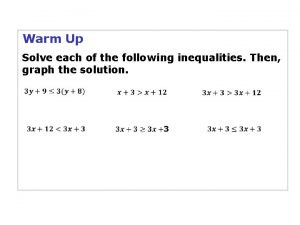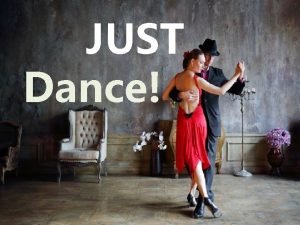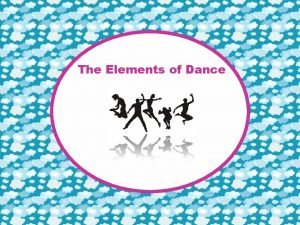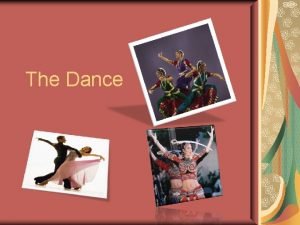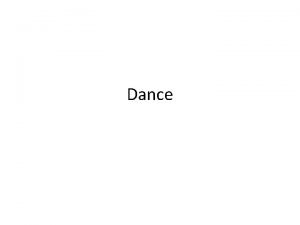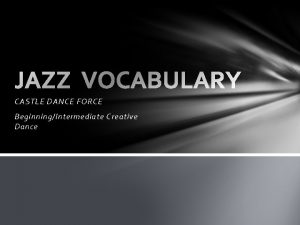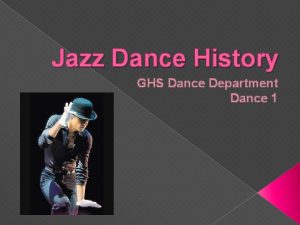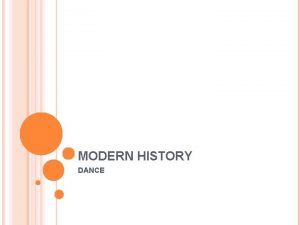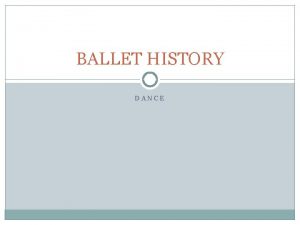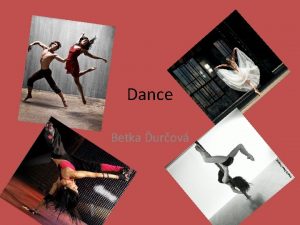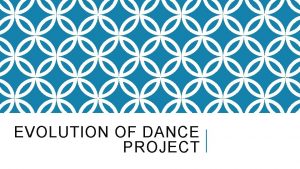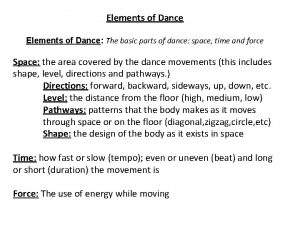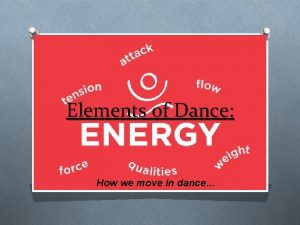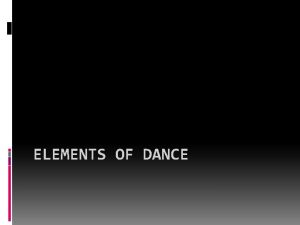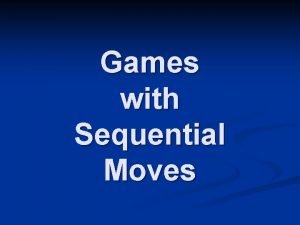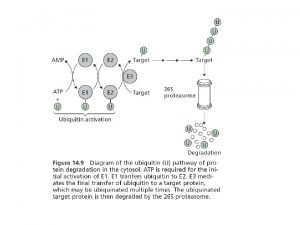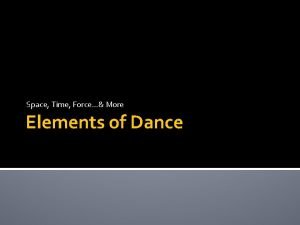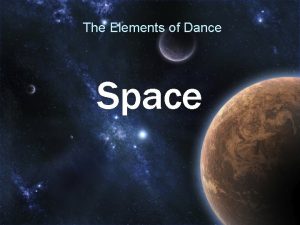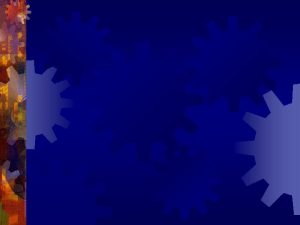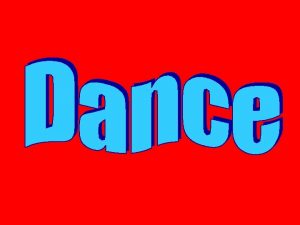The Elements of Dance SPACE Dance continuously moves

























- Slides: 25

The Elements of Dance

SPACE • Dance continuously moves through space and this makes the use of spatial elements important when choreographing a dance. • Spatial elements include – – – – Shapes Levels Direction Pathways Floor patterns Personal and general space Performance space Positions on stage

Shapes • Because of the way the body is jointed it is possible to make many different lines and shapes with individual body parts or the whole body. • During a dance shapes are created in space and the choreographer considers the effects that are created. • Curved symmetrical shapes or angular asymmetrical shapes may best meet the mood or style of a particular dance. • Arms and legs when extended make vertical, horizontal and diagonal lines. • The spine and the arms can make graceful curves. • Elbows, knees, wrists and ankles can form the ‘corner’ of sharp angular shapes.


Levels • Levels in dance refer to where the body moves in space relative to the ground. • Low levels are usually thought of as the ground • Medium is when the dancer is standing • High levels referring to the space as far away from the ground.

Low Level • Low level actions create a sense of groundedness, connection with the earth, rest or vulnerability. • Examples of low level movements could be, bending, kneeling, rolling, crawling, crouching, sitting and reclining.

Medium • Medium level shapes and actions bring a sense of human action and scale to dance. • At a medium level, the dancer moves in ways that are more like the way we normally move in space: – gestures, walking, stepping, running and balancing.

High Level • High level shapes or actions move away from the ground defying gravity by pushing up and into the air. Examples of actions that are high level include jumping, hopping and leaping

Direction • Direction in dance is the line taken by the body. Direction can refer to shapes, movements, sequences of movements or relationships between dancers. • Direction may be: – Forward or backwards – Sideways – Diagonal

Pathways • In dance pathways refer to the path or pattern made by a body part through space (nonlocomotor) • Pathways can be straight, angular, curving, symmetrical, asymmetrical or any combination of these.

Floor patterns • A floor pattern in the path or pattern a dancer makes when travelling across the floor (locomotor).

Personal space • The space around the body is called personal space. • It is also referred to as the kinesphere. • You can think of it as space created by extending your limbs without moving off the spot. • When you perform nonlocomotor movements, you do so in your kinesphere. • Your kinesphere moves with your body as you perform locomotor movements.

General space • General space is the space beyond your body that you move through as you dance. • Active space refers to general space that has been given meaning • For example: a dancer gestures out into the space as though there is something or someone there.

Positions on stage • These terms are used for actors and dancers to know where to go on stage. • They are mapped from the actor’s (or dancer’s) point of view. • Different areas of the stage can be used symbolically, or can enhance the meaning of the dance for an audience: – Centre stage draws the focus of the audience and can be seen as a powerful position – Dancers performing upstage may be viewed as a background to a focus on a dancers downstage – A dancer performing downstage can connect more intimately with an audience – Diagonal pathways are aesthetically pleasing from an audience point of view.


Time • Time is one of the elements of dance we use and manipulate when we compose movement. • We can consider how we use and combine beat, metre, duration, tempo, rhythm and stillness. • We can also consider how we will organise movement into phrases, sections and the overall structure of the work.

Duration • The term duration when referring to dance, means the length of time taken to perform a movement. • Movements of a long duration have sustained quality and may give the audience a feeling of anticipation, flow or calm. • Movements of short duration have a percussive quality and may give the audience a feeling of speed, energy and excitement.

Beat • When we dance we often move to a given beat, which is either counted for us or can be heard in the musical accompaniment. • If the beat has a short duration, the tempo of the dance is usually faster. If the beat had a long duration the tempo will be slower.

Metre • Metre is a regular grouping of beats, e. g 3 or 4 or 5 or 8. We are counting metre in dance when we count in patterns – 1234, 1234 – 123, 123 – 123456, 123456 • Metre relates to the time signature in music, which indicates the number of beats in a bar and the duration of those beats. • Dancers often count in 8 s because choreographers are using a 4/4 time signature and creating phrasing across two bars, or four counts.

Accents • Accents in dance are movements that are stressed or highlighted in some way to make them stand out. In music, accents are played more loudly to emphasise them.

Tempo • The word tempo means time in Italian. The term refers to speed or pace. The tempo is often determined by the musical accompaniment. We tend to sequence movement to match the measured beat in the music, or we may attempt to perform the sequence in half or double time.

Stillness • The term stillness, when applied to dance, means absence for movement. • Stillness provides moments of rest or tension and can be used to emphasis particular shapes or relationships in the dance, helping to focus the audience on the choreographer’s intention.

Dynamics • Interest and meaning can be added to a dance by manipulating the dynamic qualities of the movement. • Dynamics qualities can be described as the way the movement is performed. – Force: degree of energy being used in a movement – Energy – Quality of the movement: describing words

The following movements can be used to enhance the dynamics qualities of choreography: • Swinging – This type of movement creates the feeling of happiness • Suspending – Uses the moment of suspension before a movement gives way to gravity and falls away. • Collapsing – the direction of a collapse is downward and it can be slow and controlled, or a release of tension where the body gives way to gravity, it is possible to collapse the whole body or part of the body. • Percussive movement – is short, sharp, sudden and forceful. They stop and start abruptly, they can be quite dramatic when use to convey energy or aggression. • Vibratory movement – very similar to percussive movements but this is performed smaller, it can be seen as quivering or shaking. • Sustained movement – requires smooth uninterrupted flow of movement. There is no start, pause or stop. The movement is flowing at the same tempo. This type of movement requires a great deal of control.

Dynamics Reaching Choppy Swinging Crunchy Floppy Tossing Smooth Prickly Lazy resisting Stretching Slicing Folding Excitable Angry Springily Graceful Controlled Messy robotic Joyful Carving Wiggling Serious Stamping Sharp Sloppy Strong Squishy solid
 Dance dance dance in the freedom we know
Dance dance dance in the freedom we know Direction elements of dance
Direction elements of dance Macarena dance step
Macarena dance step The disco finger
The disco finger 10 example of axial movement
10 example of axial movement Compounded continuously formula
Compounded continuously formula A=pert formula
A=pert formula Pert formula compound interest
Pert formula compound interest Continuously compounded interest
Continuously compounded interest Which term is used to describe bitmap images
Which term is used to describe bitmap images What does continuously monitoring internal marketing
What does continuously monitoring internal marketing Line dance macarena
Line dance macarena Everybody dance and sing line dance
Everybody dance and sing line dance Geometry bell ringers
Geometry bell ringers The dance committee hired a dj for the fall dance
The dance committee hired a dj for the fall dance Dancing as a hobby
Dancing as a hobby Unscented trajectory chapter 5
Unscented trajectory chapter 5 Space junk the space age began
Space junk the space age began Camera space to world space
Camera space to world space Unscented trajectory chapter 5
Unscented trajectory chapter 5 World space computer
World space computer Hình ảnh bộ gõ cơ thể búng tay
Hình ảnh bộ gõ cơ thể búng tay Slidetodoc
Slidetodoc Bổ thể
Bổ thể Tỉ lệ cơ thể trẻ em
Tỉ lệ cơ thể trẻ em Gấu đi như thế nào
Gấu đi như thế nào

